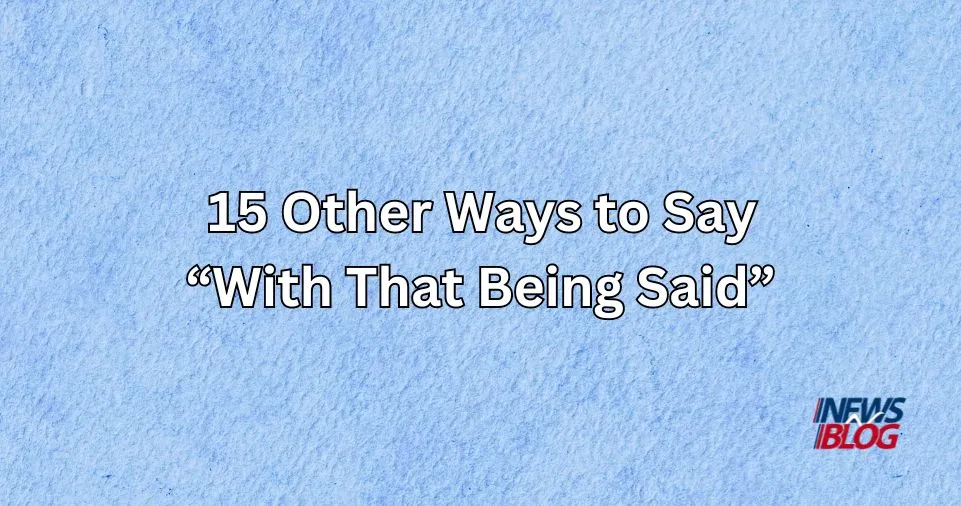Effective communication hinges on the ability to convey ideas clearly and creatively.
While “With that being said” is a common transitional phrase, diversifying your language can enhance your communication skills and make your expressions more engaging.
Here are 15 alternative phrases you can use to replace “With that being said” in various scenarios, making your speech and writing more dynamic.
15 Other Ways To Say “With That Being Said”
Here are 15 other ways to say “With That Being Said”:
In Conclusion
Using “In conclusion” effectively wraps up formal discussions or documents by summarizing key points.
Dear Sarah,
Thank you for your detailed proposal regarding the upcoming project. In conclusion, your insights on cost estimation and timeline are invaluable. Let’s schedule a meeting next week to discuss implementation strategies.
Best regards,
John
To Sum Up
“To sum up” is a concise way to encapsulate final thoughts, suitable for both written and spoken communication.
Hello Team,
After reviewing the quarterly report, it’s evident that our marketing efforts have yielded positive results. To sum up, our strategy has effectively boosted brand visibility and customer engagement.
Regards,
Alexandra
To Conclude
The phrase “To conclude” adds formality, guiding the audience towards the end of a discussion or presentation.
Dear Mr. Johnson,
Thank you for considering my proposal for the upcoming conference. To conclude, I am confident that my presentation on sustainable practices will greatly benefit the audience.
Sincerely,
David Anderson
In Summary
“In summary” offers a casual yet impactful transition, seamlessly integrating into various communication settings.
Hi Rachel,
I appreciate your input during the team meeting. In summary, let’s focus on refining our customer service procedures to enhance client satisfaction.
Best Regards,
Michael
To Wrap It Up
“To wrap it up” is excellent for adding a touch of informality to spoken presentations or informal written communication.
Hey Team,
Our brainstorming session was productive, and we’ve outlined some exciting ideas for the upcoming campaign. To wrap it up, let’s assign tasks and reconvene next week to discuss progress.
Cheers,
Emma
To Bring It All Together
This phrase emphasizes the interconnectedness of ideas, ideal for unifying communication.
Dear Mark,
Your contributions to the project have been exceptional. To bring it all together, your dedication has significantly contributed to the overall success of our team.
Warm regards,
Sophia
Considering All Aspects
“Considering all aspects” conveys a thoughtful evaluation of various perspectives.
Hello Olivia,
I’ve reviewed the proposals from different vendors, and considering all aspects, I believe XYZ Company offers the best solution for our software upgrade.
Best regards,
Daniel
Taking Everything into Account
This phrase implies a thorough examination before arriving at a final statement.
Dear Ms. Thompson,
After analyzing the market trends and customer feedback, I recommend implementing the suggested changes. Taking everything into account, these adjustments align with our long-term goals.
Kind regards,
Eleanor
To Cap It All
Inject a conversational tone while effectively signaling the conclusion of a discussion.
Hi Jake,
Our team achieved remarkable results in the last quarter. To cap it all, let’s celebrate our accomplishments and set new goals for the upcoming months.
Cheers,
Lily
In a Nutshell
“In a nutshell” is a succinct way to encapsulate the main points, suitable for both formal and informal contexts.
Dear Mr. and Mrs. Miller,
After our recent meeting, I am confident that the proposed changes will streamline our operations. In a nutshell, these adjustments aim to improve efficiency and reduce costs.
Warm regards,
Christopher
To Put It Simply
When concluding a complex topic, “To put it simply” distills intricate information into a concise statement.
Hi Brian,
I’ve reviewed the technical specifications you provided for the upcoming project. To put it simply, your proposed system architecture aligns seamlessly with our requirements.
Best Regards,
Jessica
With All Factors Considered
This phrase emphasizes a comprehensive assessment before arriving at a conclusion.
Dear Team,
After a thorough analysis of the market dynamics and competitor strategies, I propose we adjust our marketing approach. With all factors considered, this strategy aligns with current industry trends.
Regards,
Samuel
In the Final Analysis
“In the final analysis” adds formality and gravity to your conclusion, suitable for comprehensive evaluations.
Dear Ms. Turner,
After reviewing the research findings, it is clear that the proposed changes will significantly impact our project’s success. In the final analysis, I recommend moving forward with the suggested modifications.
Sincerely,
Victoria
To Get to the Point
“To get to the point” signals a concise transition to the main idea or conclusion, perfect for brevity.
Hey Chris,
Thanks for the detailed updates on the client meetings. To get to the point, I believe incorporating these suggestions will enhance our presentation and client engagement.
Best Regards,
Ryan
To Close the Discussion
“To close the discussion” signals the end of a conversation or topic, emphasizing finality.
Hello Jenny,
I appreciate the diverse perspectives shared during our team meeting. To close the discussion, let’s finalize the action items and reconvene next week to review progress.
Regards,
Marcus
Also Read: 15 Other Ways To Say “I’m Waiting For Your Response”
Conclusion
Using different phrases to say “With that being said” adds variety and interest to our conversations.
By exploring alternatives like “To sum up” or “To get to the point,” we can enhance the effectiveness and engagement of our communication.
So, next time you wrap up a discussion, mix it up and make your words stand out!

